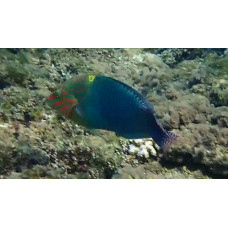Latin name
Halichoeres hortulanus
Other name
Halichoeres hortulanus
Identification
Both the sex and appearance of the Checkerboard wrasse change throughout its life and the colouration at each stage is quite variable depending on location. The body is slender and relatively elongated, with the mouth at the tip.
Features of fish fins
Dorsal spines (total): 9; Dorsal soft rays (total): 11; Anal spines: 3; Anal soft rays: 11.
Fish colouring
When young, the Checkerboard wrasse has a silver-white background with three black and dark red vertical bars on the nape, midbody and caudal peduncle. A black eye with a yellow ring adorns the back of the dorsal fin, and two distinctive white spots are also visible above and below the caudal peduncle. There is also a reddish line running across the eyes from the tip of the snout.
In the terminal stage (after sexing at maturity), the colouration of the fish varies greatly. It can be white to greenish on the ground and blue to black on the edges, resembling a checkerboard pattern. The head is greenish, with pink lines that turn to spots behind the eyes to the base of the dorsal fin. There is a bright yellow spot on the edge of the lateral and dorsal fins. Some variations in colouration are possible, for example a black spot may appear immediately after the characteristic first yellow spot, and a second bright yellow spot may be seen along the edge of the dorsal fin, but this will be discussed later. In the Red Sea, half of the back of some individuals may be blue. The caudal fin is truncated and is usually yellow with a pinkish pattern that can be faded or completely blue.
Distribution
Widespread in the tropical and subtropical waters of the Indian Ocean, from the Red Sea to South Africa and the oceanic islands (French Polynesia) of the central Pacific. The northern limit of its range is in southern Japan and the southern limit is on the Great Barrier Reef.
Habitat
A tropical marine species. Occupies clear lagoons and inshore reefs at depths of 1 to 30 m (3.3 to 98.4 ft).
Size
It is a small fish that can reach a maximum length of 27 centimetres.
Behavior
Juvenile checkerboard wrasse are often found at the bottom of tidal channels.
Food and feeding habits
A predator that feeds mainly on small invertebrates such as crustaceans, molluscs, worms and echinoderms caught on the bottom or in the sand.
Reproduction
The checkerboard wrasse is an ancestral hermaphrodite that begins life as a female and later becomes a male, changing sex in adulthood when it reaches about 12.8 centimetres (5.0 inches) in length.
Fishing
This species is of minor importance to the local commercial fishery.
Relationship with a person
Harmless. The Checkerboard wrasse is available in the aquarium trade.
| Classification | |
| Phylum | Chordata |
| Class | Actinopterygii |
| Squad | Labriformes |
| Family | Labridae |
| Genus | Halichoeres |
| Species | H. hortulanus |
| Features | |
| Conservation status | Least Concern |
| Habitat | Pelagic |
| Life span, years | No information |
| Maximum body weight, kg | No information |
| Maximum length, cm | 27 |
| Sailing speed, m/s | No information |
| Threat to people | Edible |
| Way of eating | Predator |
Checkerboard wrasse
Tags: checkerboard wrasse


